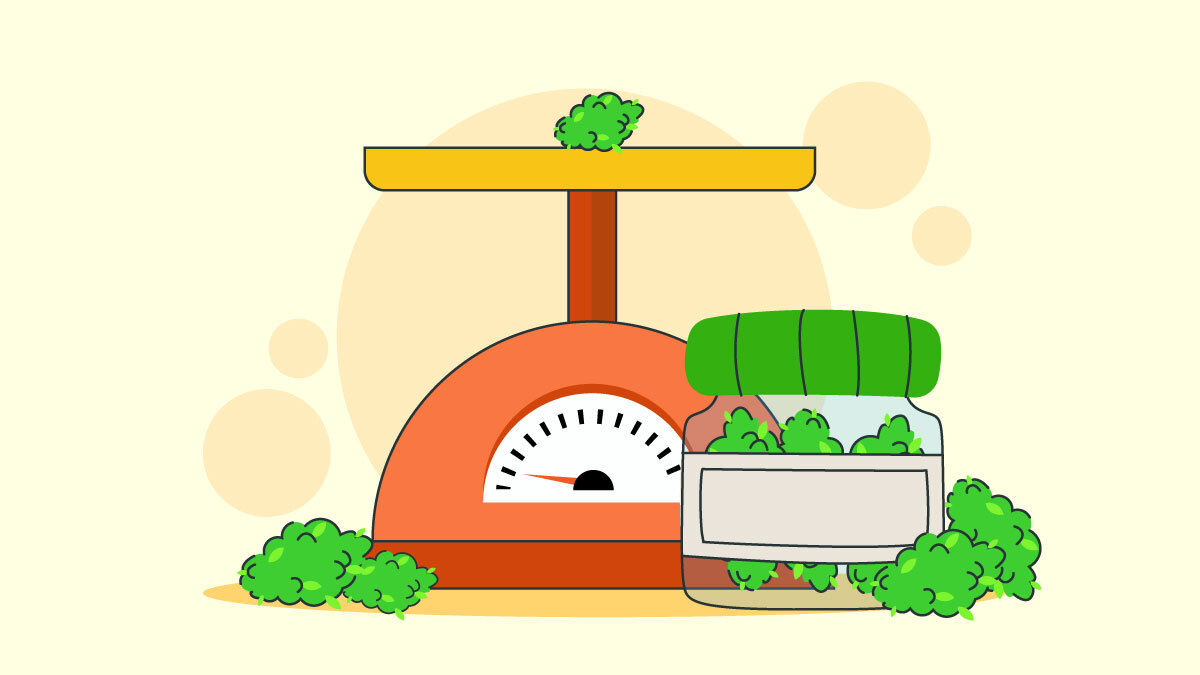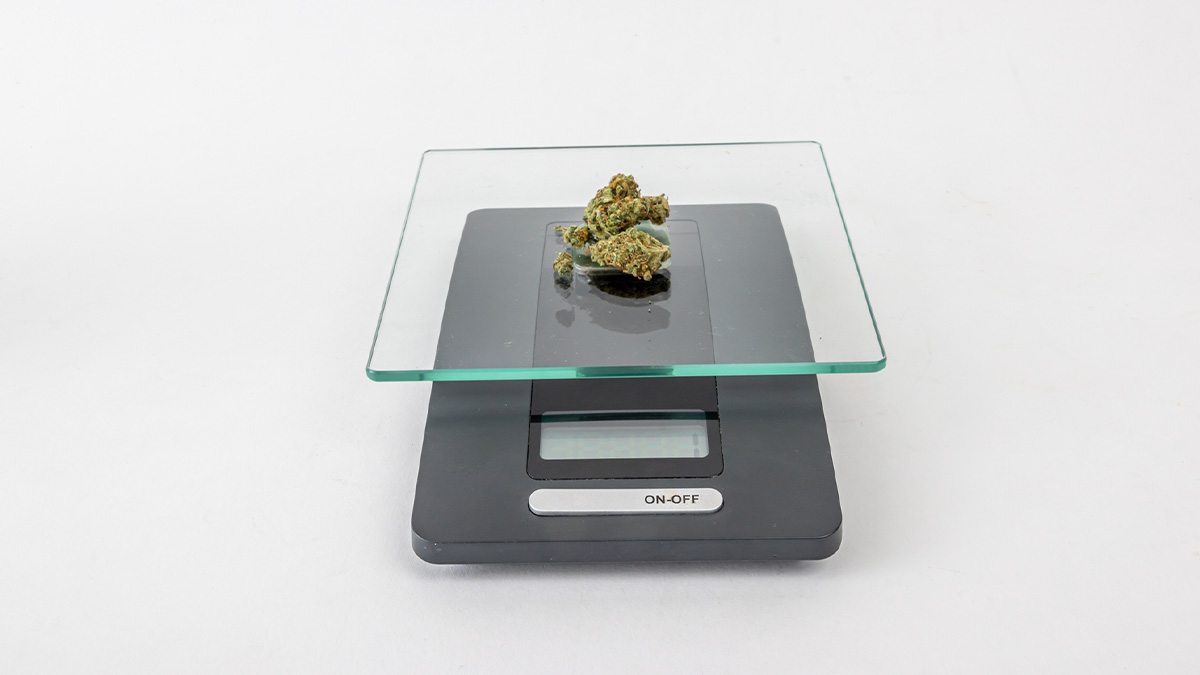How Much Is a Gram of Weed?

The prices of products depend on what they are, where you purchase them, and who you buy them from.
- Products cost more when you buy them from a middleman instead of directly from the factory.
- A Porsche costs tens of thousands of dollars more than a Hyundai.
- Groceries cost 25% more in Hawaii than they do in Mississippi.
If you haven’t guessed by now, we’re trying to make a point about weed prices.
Top-shelf flower costs more than schwag. Prices may be quite different if you’re in a legal or illegal state. And the prices you pay at a dispensary and to a dealer usually won’t be the same.
So how much does a gram of weed cost? We can’t answer that question.
But we can give you some estimates.
How Much Is a Gram of Weed?

Before we get to pricing, let’s make it clear exactly how much bud we’re talking about.
Amounts of weed are measured by their weight, but the scale of measurement that’s used is sort of odd. Very small amounts are measured in grams, but larger amounts are measured in pounds or ounces.
That means you’d buy a pound or half-pound of cannabis if you’re a dealer, a dispensary, or have a lot of money to burn. The most that people can commonly afford (and find) is a quarter pound (often called a QP). More common purchases are an ounce, a half-ounce (a half), a quarter-ounce (a quarter), or an eighth of an ounce (an eighth).
No one wants to measure anything in fractions smaller than that, though. So if you want to purchase less than an eighth, you’ll be purchasing by the gram instead.
Here’s the easiest way to visualize it. (All equivalents are approximate.)
- One pound = 453 grams
- Half-pound = 227 grams
- Quarter-pound = 113 grams
- Ounce = 28 grams
- Half = 14 grams
- Quarter = 7 grams
- Eighth = 3.5 grams
So a gram of weed is significantly less than 1/16th of an ounce. In fact, it’s 1/28 of an ounce. If you were to use a measuring spoon, a gram of weed wouldn’t even fill up ¼ of a teaspoon.
What can you do with that small amount of weed?
You can roll a healthy-sized joint or a couple of small ones. You can pack two or three bowls. You can decarb it and make a small batch of edibles.
Or you can look at it and say, “Damn. I need to buy more weed than this.”
Let’s assume that you only want a gram, though. How much will it cost?
Factors Affecting the Cost of Weed
We alluded to the many variables affecting the price of weed at the start of this article. Let’s dig into each of them a little more deeply.
1. Quality
It doesn’t matter whether you’re purchasing a gram or a QP; highly-valued strains like White Fire OG or Loud Dream are going to cost you more than the “I have no idea what strain it is — it’s weed” that an anonymous dealer may try to sell you.
That’s always the case, no matter what you’re purchasing. A high-end product is going to cost you more than the generic equivalent, or in this case, schwag. And cannabis grown by a high-quality producer, who has to pay for irrigation, humidity control, and lighting systems, is going to be more expensive than the stuff grown in someone’s backyard or closet.
Naturally, the price difference won’t be huge if you’re only buying a gram. But you’ll pay more for quality.
2. Location. Location. Location
If you live in a state where there are no legal dispensaries, the chances are good that you’ll have to pay more for a gram than you would in a “legal” state. The reason is simple: the dealers in illegal states don’t have to compete with dispensaries.
However, those who live in legal states may find that dealers charge less for weed than dispensaries. The reason can be explained by two words: overhead and taxes.
Dealers don’t have to pay for storefronts, utilities, licenses, or (in some states) unionized employees, nor do they have to pay state taxes on their sales. In some states, dispensaries charge as much as 25-35% more than dealers.
Prices vary widely between legal dispensaries, too. Some states only issue a few licenses, while there’s widespread competition between dispensaries in other states. The number of licensed growers in a state also matters. That’s why flower costs a lot less in Colorado than it does in Michigan.
3. Supply and Demand
We probably don’t have to spend much time explaining this one. If there’s a lot of weed available on the wholesale market, dealers and dispensaries will pay less for it. You will, too. If there’s a shortage, that will be reflected in higher prices. And if lots of people want weed (like they did at the height of the pandemic), that will drive prices up as well.
OK, so that brings us to the big question.
On Average, How Much Does a Gram of Weed Cost?
A gram is such a small amount of pot that there aren’t a lot of surveys done on prevailing prices.
The most recent study was released in 2022 but used data from late 2020. It’s courtesy of the statistics company Statista [1], which checked the average price of a gram of weed in ten major cities:
- Boston: $15.90
- Atlanta: $14.10
- Dallas: $10.00
- Denver: $10.00
- Miami: $10.00
- Chicago: $10.00
- Detroit: $10.00
- New York City: $9.70
- Minneapolis: $8.50
- Phoenix: $8.50
Clearly, the price doesn’t vary by much since the amount we’re talking about is so small. You’ll almost always find that a gram of weed costs somewhere between $7 and $17.
If that price sounds high, here’s a little more data to help you put the numbers in greater perspective. You could pay as much as $30 per gram in some Asian cities. And the price doesn’t seem low if you compare it to countries like Ecuador — where Vice News says a gram of weed costs a little over a dollar.
How Much Does a Gram of Weed Cost?
Q: Do people really buy only enough weed to roll a single joint?
A: Yes, if that’s all the money they have in their budget. More often, though, people buy a gram of flower just to sample a strain they haven’t tried before and decide whether they want to make a bigger financial investment.
Q: When you mentioned prices per gram, why you didn’t account for the quality of the weed?
A: A gram is such a small amount that prices don’t vary all that much, whether you’re purchasing a gram of top-shelf weed or a gram of mids. However, the numbers we cited were for average-grade cannabis; you’ll pay slightly more for a high-quality product and slightly less for reggie weed.